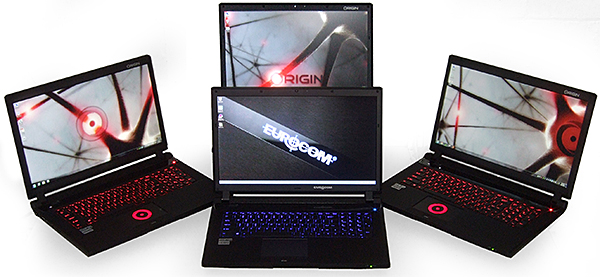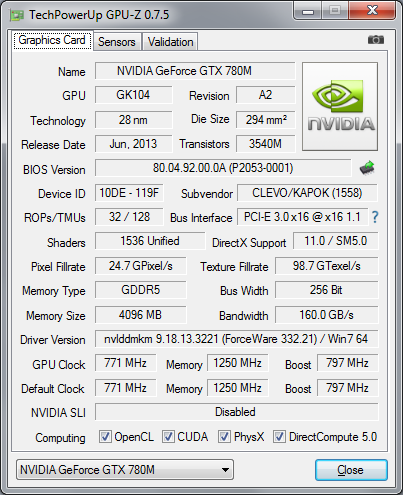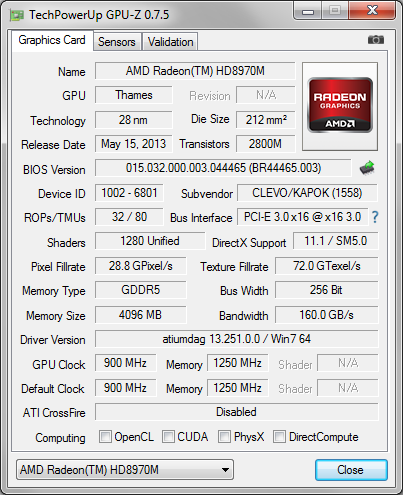GeForce GTX 780M, 770M, And 765M: Scaling Vs. Radeon HD 8970M
We already have a really good idea how desktop-bound graphics cards perform. But what about the mobile hardware typically derived from those same GPUs? We test four identically-configured notebooks and show how they scale in six popular games.
Getting A Bead On Mobile Graphics Performance
Sometimes it's hard to know how a mobile graphics processor will perform based on its name alone. Both AMD and Nvidia refer to their mobile solutions using branding very similar to their desktop parts. To help us nail down expectations of its fastest laptop GPUs, Nvidia sent over ten grand worth of Origin PC notebooks armed with GeForce GTX 780M, GeForce GTX 770M, and GeForce 765M cards.
I also wanted a bit of relativity, though. So I called up the folks at Eurocom for something comparable based on AMD's top-end graphics processor.
Origin PC recently unveiled its Genesis and Millennium cases, which were custom-designed for the company's gaming-oriented desktop PCs. Fortunately for us, though, Origin's Eon17-S uses Clevo’s P177SM chassis, which meant that Eurocom could send over a comparable system with a Radeon HD 8970M-based module with the same cooling system. An identical thermal solution is one more way we can give you benchmark results that are truly apples-to-apples.
Comparing Mobile GPUs
GPU-Z reports lower clock rates for Nvidia’s mobile GeForce modules than the manufacturer specifies, though that's likely a result of running at lower idle frequencies. Similarly, we had to load down the Radeon module with a 3D task to get its clock settings to show up at all.
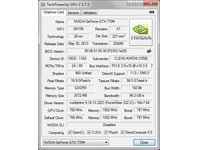
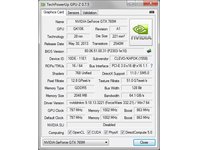
A quick look at the GeForce GTX 780M’s specifications shows that it's derived from the same GK104 GPU used for several of Nvidia's desktop-oriented cards. Naturally, the company uses lower core and memory clock rates to bring wattage down to levels that are manageable in the confines of a notebook chassis.
In case you're not familiar with the name of Nvidia's GeForce GTX 760 Ti in the chart below, it's an OEM-rebrand of the GeForce GTX 670.
| Nvidia GeForce GTX 700-Series Specs | |||||
|---|---|---|---|---|---|
| Row 0 - Cell 0 | GeForce GTX 780 | GeForce GTX 780M | GeForce GTX 770M | GeForce GTX 765M | GeForce GTX 760 Ti (670) |
| Shaders | 2304 | 1536 | 960 | 768 | 1344 |
| Texture Units | 192 | 128 | 80 | 64 | 112 |
| Full Color ROPs | 48 | 32 | 24 | 16 | 32 |
| Graphics Clock MHz (Boost) | 863 | 823 | 811 | 850 | 915 |
| Texture Fillrate | 166 Gtex/s | 105.3 Gtex/s | 64.9 Gtex/s | 54.4 Gtex/s | 102.5 Gtex/s |
| Memory Clock | 1502 MHz | 1250 MHz | 1000 MHz | 1000 MHz | 1502 MHz |
| Memory Bus | 384-bit | 256-bit | 192-bit | 128-bit | 256-bit |
| Memory Bandwidth | 288 GB/s | 160 GB/s | 96 GB/s | 64 GB/s | 192 GB/s |
| Graphics RAM | 3 GB GDDR5 | 4 GB GDDR5 | 3 GB GDDR5 | 2 GB GDDR5 | 2 GB GDDR5 |
| Die Size | 561 mm² | 294 mm² | 221 mm² | 221 mm² | 294 mm² |
| Transistors (Billion) | 7.1 | 3.54 | 2.54 | 2.54 | 3.54 |
| Process Technology | 28 nm | 28 nm | 28 nm | 28 nm | 28 nm |
| Price | $500 | ~$750 | ~$400 | ~$300 | ~$300 |
AMD’s Radeon HD 8970M is also the product of recycled naming, though more severely. Once upon a time, this exact configuration was called the Radeon HD 7970M, though it was based on the desktop Radeon HD 7870. AMD makes big cuts in power consumption by underclocking the Pitcairn GPU sitting on its flagship notebook module.
Get Tom's Hardware's best news and in-depth reviews, straight to your inbox.
| AMD Radeon HD 8000-Series Specs | ||||
|---|---|---|---|---|
| Row 0 - Cell 0 | Radeon HD 8970/7970 [280X] | Radeon HD 8970M | Radeon HD 7970M | Radeon HD 7870 |
| Shaders | 2048 | 1280 | 1280 | 1280 |
| Texture Units | 128 | 80 | 80 | 80 |
| Full Color ROPs | 32 | 32 | 32 | 32 |
| Graphics Clock MHz (Boost) | 1000 (1050) [850/1000] | 850 (900) | 850 | 1000 |
| Texture Fillrate | 128 Gtex/s [109] | 68 Gtex/s | 68 Gtex/s | 80 Gtex/s |
| Memory Clock | 1500 MHz | 1200 MHz | 1200 MHz | 1200 MHz |
| Memory Bus | 384-bit | 256-bit | 256-bit | 256-bit |
| Memory Bandwidth | 288 GB/s | 154 GB/s | 154 GB/s | 154 GB/s |
| Graphics RAM | 3 GB GDDR5 | 4 GB GDDR5 | 4 GB GDDR5 | 2 GB GDDR5 |
| Die Size | 352 mm² | 212 mm² | 212 mm² | 212 mm² |
| Transistors (Billion) | 4.3 | 2.8 | 2.8 | 2.8 |
| Process Technology | 28 nm | 28 nm | 28 nm | 28 nm |
| Price | $400 | ~$500 | ~$500 | $200 |
Current page: Getting A Bead On Mobile Graphics Performance
Next Page Benchmarking Configurations-
outlw6669 Nice review.Reply
I can honestly that I was not expecting Pitcairn to perform so well against GK104 while also maintaining lower power consumption! -
guvnaguy Are Optimus or Switchable Graphics available in these systems?With those solutions around, I wish we could start seeing reasonable (>4-5 hr) battery life out of these laptops when not under load.Reply -
damric In about a year or so when there is a catalog of Mantle games, laptops could make a comeback as a viable gaming platform under $1500.Reply -
blackmagnum When will they make mainstream external boxes for these gaming cards? Give it a cheap and fast link to a notebook and price it competitively to the gaming laptops; awesome upgrades like the desktop crowd.Reply -
San Pedro I really like my 8970M. It's awesome having that much power in a notebook. I just hope it doesn't die like my 6990M did.Reply -
cats_Paw A great place to check GPUs in laptops and laptops in general is notebookcheck.netIts especially important because heat can be a problem in laptops very, very fast.Sure those did not seem to have that problem but ambient temps, as well as dust acumulation are two factors rearly taken into consideration when talking about overheating.Reply -
daglesj I have seen people buy the kind of laptops that these cards exist in. The main issue with them is that they are often so compromised in one way or another they spend more time getting sent back for repairs and fixes than they do on the owners desk.Like TVR cars, they did more miles strapped on the back of low loaders going to and from Blackpool than actually on its own wheels.Reply -
gxpbecker the wife has a MSI i7QM 3630 i believe and a 670mx. It has been over a year and still runs strong. Alpha testing EQNLandmark with her laptop and it runs like a champ on a mix of ultra and high settings. we have not had one issue with it and runs pretty dang cool and quiet for a gaming laptop. not sure what machine the people you have seen Daglesj, but we are very happy with ours.Reply -
manitoublack Wish you included the GT750m SLi available on the Lenovo Y510P. I own said laptop and $ for $ couldn't ask for more, but have no real goal post against the other chips in the Nvidia range.Great to finally see some mobile GRFX chop reviews and look forward to more in the future.Reply
